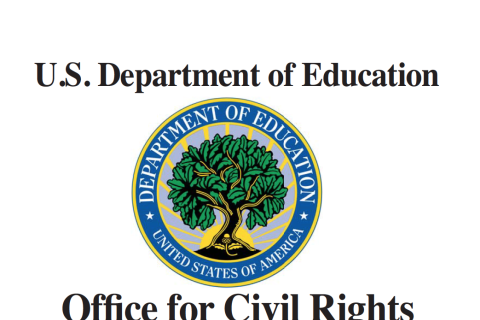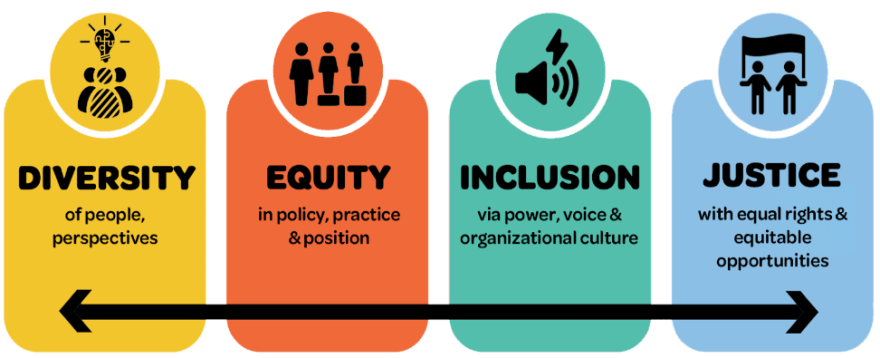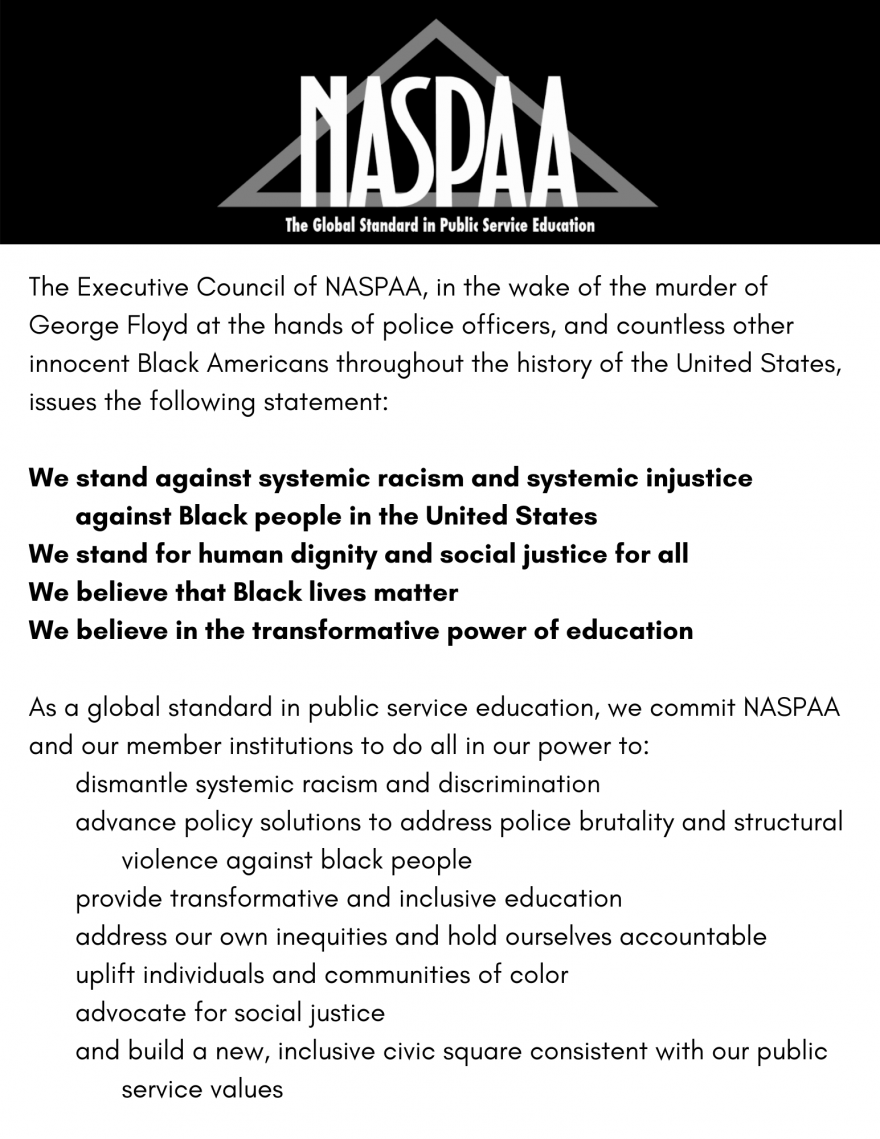
NASPAA DEIJA Action Plan
NASPAA Diversity, Equity, Inclusion, Justice, and Accessibility Action Plan Introduction
In its October 19, 2022 strategic planning session at the Network of Schools of Public Policy, Affairs, and Administration (NASPAPA) 2022 Annual Conference, the Executive Council engaged in significant discussion involving how diversity, equity, and inclusion (DEI) should be integrated into NASPAA’s efforts moving forward. The following areas of focus were obtained from those deliberations.
- DEI is not a question; it is central to who we are, and a greater focus will be placed on DEI
- An equity commitment will be embedded in everything NASPAA does from accreditation to internal programs, policies, and procedures as well as member institutional support
- DEI will be integrated into NASPAA’s strategic plan that will change as needed over time to support internal needs and member institutions
- NASPAA will institute actions to move from English-only materials and to develop resources that allow movement beyond the United States while reviewing its programs and practices for U.S.-centric processes and practices
- NASPAA will integrate a “How Can We Help?” mindset into its efforts and will develop a DEI toolkit to be of service to its member institutions as they develop their own DEI plans
- NASPAA practices will be reviewed on an ongoing basis for “equity” versus “equality”
NASPAA is the global standard in public service education. NASPAA is a nonprofit 501(c)(3) membership association with over 300 institutional member schools at U.S. and non-U.S. universities that award degrees in public administration, public policy, public affairs, nonprofit and related fields. NASPAA is the recognized global accreditor of master's degree programs in these fields. NASPAA has over 23,000 students enrolled across the globe and is represented in 23 countries.
This document is designed to address the global needs of NASPAA by providing a DEI specific strategic action plan to address the Executive Council’s stated plans at the 2022 conference in Chicago. The plan will serve as the foundation for implementing the organization’s “Framework for Diversity, Equity, and Inclusion Action.” The plan will assist NASPAA in greater allyship by providing a framework for member institutions to address racial and other identity-based inequities, historic exclusion, and upward mobility based on the primary and secondary dimensions of diversity; and related impacts to institutional quality of life.
NASPAA is also a membership association with institutional member schools at U.S. and non-U.S. universities. Its constituents and employees are comprised of different races, abilities, colors, faiths, ethnicities, nationalities, and sexual/gender orientations. The organization holds the same diverse representation of life as does the world. NASPAA’s leaders and staff understand that there is more that unites their global organization than divides it and, as an organization that values diversity, equity, and inclusion they must remain mindful of the commonalities that comprise the very fabric and makeup of the organization and its member institutions.
“During summer and early fall of 2020, six members of the Diversity and Social Equity Committee of NASPAA joined with six members of NASPAA's Executive Council to form an ad hoc Task Force to review background materials and propose a comprehensive Framework for a Diversity, Equity, and Inclusion Action Plan to guide NASPAA's work on these important issues over the coming years. This taskforce was initiated in response to the killing of George Floyd and a desire for NASPAA to move toward intentional actions to become a model for member institutions in the fight against anti-Black racism, discrimination, and inequity globally. The Action Plan is intentionally designed as a framework that can be built on and tweaked over time as the organization makes ever more progress to comprehensively integrate diversity, equity, and inclusion goals in the following key areas:
- Accreditation
- Teaching and Learning
- Delivering Diversity in NASPAA and our Field
- Research and Recognition
- Annual Conference Planning
- Communications and Internal Training
NASPAA’s intention is to become a model organization for its member institutions, staff, board members, constituents, and partners to emulate as they address discrimination, exclusion, inequity, and unfair treatment based on identity. The idea is to present a global model which addresses DEI issues and concerns in the countries of its international partners and collaborators, as well as the United States.
This action plan is interactive and experiential in that it provides opportunities for NASPAA associates to engage one another in honest and substantive dialogue around issues of diversity, equity, inclusion, and respect. As a global standard in public service education, NASPAA has publicly committed to do all in its power to:
- Dismantle systemic racism and discrimination, domestically and internationally
- Advance policy solutions to address police brutality and structural violence against people of color, domestically and abroad
- Provide transformative and inclusive education, internally and externally
- Address its own inequities and hold itself accountable
- Uplift individuals and communities of color across the globe
- Advocate for social justice for everyone
- Build a new, inclusive civic square consistent with NASPAA’s public service values
- NASPAA values a culture of respect and an inclusive environment built on mutual trust, respect, and dignity. NASPAA pledges to identify and eliminate barriers to DEIJA within the organization.
- NASPAA will take appropriate measures in a timely manner to address incivility or demeaning behaviors by anyone within our internal organization. This includes executive council, staff, and third-party individuals (i.e., vendors, customers, clients, independent contractors or other organizational outsiders interacting with NASPAA).
- NASPAA requires fair treatment and accessibility to its programs and services for all member institutions.
- NASPAA values the importance of a personalized approach to DEIJA assistance for each of its member institutions as defined by their organizational needs and challenges.
- NASPAA encourages all members and member organizations to use their unique perspectives to help advance DEIJA within NASPAA.
- NASPAA will support and facilitate the sharing of the best practices of its member institutions to help advance DEIJA within NASPAA.
- NASPAA promotes incorporation of DEIJA in all facets of the organization.
- NASPAA will be a leader and active collaborator in building a public square where all members and member institutions can share beliefs, thoughts and viewpoints in a civil, safe, and respectful space.
NASPAA DEIJA Vision
An organization where diversity, equity and inclusion are the foundation for safe, fair, and inclusive public service.
NASPAA DEIJA Mission
NASPAA’s twofold mission is to ensure excellence in education and training for public service and to promote the ideal of public service.
GOAL 1. ACCREDITATION Increase NASPAA accreditation at HCBUs and other underrepresented organizations associated with the organization domestically and internationally.
GOAL 2. TEACHING AND LEARNING Serve as a resource and clearinghouse in support of the promotion and encouragement of NASPAA member institutions, staff, board members and stakeholders to engage in the DEIJA work.
GOAL 3. DELIVERING DIVERSITY IN NASPAA AND OUR FIELD Develop and implement pipeline projects for NASPAA program activities, DEIJA recruitment assistance to member institutions, engagement opportunities for members, and heighten awareness of leadership and career opportunities within NASPAA for the purpose of improving DEIJA.
GOAL 4. RESEARCH AND RECOGNITION Apply a DEIJA lens to all NASPAA awards, programs, and recognitions.
GOAL 5. ANNUAL CONFERENCE PLANNING Review all NASPAA future conference planning and practices with an eye toward amplifying diversity, access, equity, and inclusion.
GOAL 6. COMMUNICATIONS AND INTERNAL TRAINING Conduct a NASPAA DEIJA organizational assessment to identify barriers, obstacles, and areas of
DEIJA Action Plan
1.1 Institute actions to develop resources that allow -outreach and support beyond the United States while reviewing practices for U.S.-centric processes.
1.2 Publicize NASPAA Definition of DEIJA with the objective of integrating it uniformly across all programs, practices, and initiatives.
1.3 Develop a training framework for COPRA
1.4 Provide assistance to COPRA ensuring the understanding of the needs/challenges of programs in meeting the NASPAA Accreditation Standards involving DEIJA.
2.1 Serve as a resource and clearinghouse in support of the promotion and encouragement of NASPAA member institutions to engage with the work of the American Association of Colleges and Universities (AAC&U) Truth Campus Centers.
2.2 Create source templates to guide NASPAA member institutions in developing instructor cultural competencies required to create an equitable and inclusive classroom climates.
2.3 Craft source templates to guide NASPAA member institutions in initiating and supporting active discussions about DEIJA and its relationship to the role of doctoral programs in pedagogical instruction and preparation.
2.4 Provide leadership in the development of new and evolving DEIJA trainings, webinars, video briefs and other materials for instructors, administrators, and leadership on integrating equity and inclusion in degree program curricula.
2.5 Construct a sustainable interface with the Journal of Public Affairs Education with the intentional objective of encouraging pieces on DEIJA pedagogy.
2.6 Design an ongoing process for continuous assessment of the current state of equity and inclusion in MPA program curricula utilizing the programs’ DEIJA plans.
2.7 Serve as an information clearinghouse supporting the development of additional instructor support, training, and resources as needed. 2.8 Develop reporting templates for programs to provide evidence of faculty professional development in promoting a climate of inclusiveness.
2.9 Review the NASPAA Inclusion Badge requirements and update as needed to better reflect DEIJA practices.
2.10 Structure an analytical process to document MPA programs’ increased efforts to promote a climate of inclusiveness from programs accredited under the 2019 revised standards.
2.11 Institute reporting templates for faculty professional development in promoting a climate of inclusiveness, enforcing standards, and holding programs accountable.
3.1 Facilitate the creation of an engaged, diverse group of NASPAA members to define an “Aspirational NASPAA”: what do we want to see for NASPAA in 2050?
3.2 Integrate DEIJA goals into the annual evaluations of the Executive Director and staff.
3.3 Institute a defined DEIJA professional development program for the continuous improvement of NASPAA staff.
3.4 Develop timelines for conducting periodic audits and reviews of NASPAA DEIJA practices.
3.5 Establish an accountability structure for diversity within NASPAA as an organization.
3.6 Develop and implement pipeline projects for NASPAA program activities, DEIJA recruitment assistance to member institutions involving PhD program candidates and faculty members, career leadership pathways for diverse candidates, engagement opportunities with HBCUs and MSIs, and heighten awareness of leadership and career opportunities within the NASPAA organization for the purpose of improving DEIJA.
3.7 Define behaviors around the NASPAA Definition of DEIJA that are evidenced by the organization, its leadership and staff in their actions, programs, and initiatives as well as throughout its leadership and committee structures.
4.1 Apply a DEIJA lens to all NASPAA awards.
4.2 Continuously promote NASPAA’s Diversity Award, Social Justice Curriculum Award, and Social Equity Award to create greater awareness and engagement across member institutions.
4.3 Develop and expand the Badging Process with an eye toward DEIJA principles and aspirations.
4.4 Create NASPAA initiatives and programs to expand recognition of innovative practices and scholarship in Public Administration programs at MSIs, specifically HBCUs, TCUs, HSIs, and others.
5.1 Review all NASPAA conference practices with an eye toward amplifying diversity, access, equity, and inclusion.
5.2 Develop an annual NASPAA Conference DEIJA training event for participants at all stages of their academic career.
5.3 Construct a permanent conference panel of recent DEIJA-related award recipients with term limitations so they can more deeply share their work, innovations, best practices, etc., involving new DEIJA science or expanding the existing body of knowledge.
6.1 Develop compelling messages, including opportunities for dialogue, that encourage all NASPAA associates to see the importance of DEIJA to their personal success and the success of NASPAA.
6.2 Coordinate with NASPAA stakeholders and associates to include DEIJA when crafting and issuing internal and external communications and acquiring information technology solutions (e.g., inclusive visuals and language, reasonable accommodation language, etc.).
6.3 Conduct a NASPAA DEIJA organizational assessment to identify artificial barriers, obstacles, and areas of improvement in organizational programs, policies, and practices.
6.4 Develop a list of common definitions of Diversity, Equity, Inclusion, Justice, and Accessibility terminology for all NASPAA staff, associates, and board members.
6.5 Take steps to ensure that NASPAA staff and board members understand their responsibilities and expectations under NASPAA’s Framework for a Diversity, Equity, Inclusion, Justice, and Accessibility Action Plan.
6.6 Ensure that NASPAA staff and board members understand that Diversity, Equity, Inclusion, Justice, and Accessibility are important in the organization’s space, and it benefits and applies to all associates, regardless of their geography or identity.
6.7 Ensure that NASPAA staff and board members become more aware of their own personal values and how their past has created their current perceptions and behaviors around Diversity, Equity, Inclusion, Justice, and Accessibility.
6.8 Ensure that NASPAA staff and board members gain new perspectives to recognize and respect Diversity, Equity, Inclusion, Justice, and Accessibility.
6.9 Ensure that NASPAA staff and board members learn to resolve interpersonal conflict and how to maximize the benefits of a diverse, equitable and inclusive organization.
6.10 Ensure that NASPAA staff and board members understand their own implicit biases to avoid bias traps and to be comfortable with being held accountable regarding DEIJA.
6.11 Ensure that NASPAA staff and board members develop personal responsibility on how they might use their respective roles in NASPAA to transform the organization’s organizational culture to one where all associates will be treated fairly and with respect regardless of their identity.
|
Authentic Self |
Who an individual is as a person, demonstrating different experiences, perspectives, cultures, history, etc., without being forced to conform to the majority culture in the workplace. The work culture must value a wide range of talents, skills, and experiences to create a sense of belonging for everyone without causing harm to others. |
|
Cultural Competency |
The ability to understand, accept, and interact with individuals of different backgrounds and cultures. |
|
Disability |
A physical or mental impairment that substantially limits one or more major life activities. |
|
Disabled Veteran |
A person who has served on active duty in the armed forces, has separated under honorable conditions, and has established the present existence of a service-connected disability or is receiving compensation, disability retirement benefits, or pension because of a public statute administered by the Department of Veterans Affairs or a military department. |
|
Diversity |
Diversity encompasses the range of similarities and differences each individual brings to the workplace, including but not limited to, national origin, language, race, color, disability, ethnicity, gender, age, religion and belief, sexual orientation, gender identity, socioeconomic status, veteran status, family structure, and diversity of thought, all of which is shaped by culture, background, experiences, and other elements. |
|
Equity |
Consistent, systematic, fair, just, and impartial treatment, access, opportunity, and advancement for all individuals, including individuals who historically have been denied such treatment, while striving to identify and eliminate barriers that might prevent any employee’s full and equitable participation in the workplace. |
|
Inclusion |
Inclusion is a set of behaviors (e.g., welcoming new employees, paying attention and extending an invitation, seeking, and respecting other perspectives, etc.) that promote equal access to opportunities and resources for individuals who might otherwise be excluded or marginalized. |
|
Individual/Person with a Disability |
A person with a physical or mental impairment that substantially limits one or more major life activities (such as walking, talking, seeing, hearing, or learning), has a record of such impairment, or is regarded as having an impairment unless the impairment is both transitory and minor. |
|
Reasonable Accommodation |
Any change in the work environment (or in the way things are usually done) to help a person with a disability apply for a job, perform the essential duties of a job, or enjoy the benefits and privileges of employment. |
|
Self-Identification of Disability |
The voluntary completion and submission of information from the Office of Personnel Management’s (OPM’s) Standard Form 256 (SF 256) identifying that a person has a disability, either by hard copy of the SF 256 to the servicing Human Resources Branch personnel in the Division of Administration, or electronically through the MyEPP system using the appropriate code from the SF 256. |
|
Talent Acquisition |
Long-term human resources planning and finding appropriate candidates for positions that require specific skillsets to fulfill a business need. |
|
Targeted Disability |
Specific, severe disabilities targeted for emphasis in affirmative action planning that include, but are not limited to, developmental disabilities, traumatic brain injury, deafness, blindness, missing extremities, partial paralysis, complete paralysis, epilepsy, intellectual disabilities, psychiatric disabilities, dwarfism, and significant disfigurement. |
|
Underserved Communities |
Populations sharing a particular characteristic, as well as geographic communities, that have been systematically denied a full opportunity to participate in aspects of economic, social, and civil life. |
|
Unseen Diversity Characteristic |
Non-visible personal characteristics such as background, culture, and personality, as well as protected classes such as disability, sexual orientation, gender identity, gender expression, religion, and belief. |
DEIJA Resources for Programs
-

Policy Guidance from the Office of Civil Rights
See policy guidance from the Office of Civil Rights to inform how schools in the United States operate, following the recent Supreme Court decisions.
-

DEI Special Meeting Resource Links
On September 15, 2023 NASPAA's Executive Council met with Dr. Janice Underwood, Director of the Office of Diversity, Equity, Inclusion, and Accessibility (ODEIA) at the Office of Personnel Management (OPM). Dr. Underwoord shared a number of resources pertinent to our members.
-

Strategies for Increasing Diversity and Opportunity in Higher Education
U.S. Department of Education Reportthe U.S. Department of Education released “Strategies for Increasing Diversity and Opportunity in Higher Education,” a report to guide state and higher education leaders on policies and practices to advance diversity on college campuses. The report reviews evidence-based strategies and promising practices in the areas of outreach, admissions, financial aid and funding, and college completion. The report will serve as a resource to help guide institutions and states as they respond to the Supreme Court’s decision in Students for Fair Admissions, Inc. v. President and Fellows of Harvard College and Students for Fair Admissions, Inc. v. University of North Carolina et al. (collectively “SFFA”).
-

Intercultural Competencies, Global Learning, and Preparing for Environmental Sustainability
DIversity and Social Equity Committee WebinarThe webinar delves into the significance of building intercultural competencies through global learning to equip learners to effectively advance the Sustainable Development Goals (SDGs). Its primary emphasis lies on fostering peer collaboration across various disciplines to facilitate the implementation of public projects and programs.
June 11, 2020 Statement from the NASPAA Executive Council on the murder of George Floyd


